Why your turned out duck feet are trashing your body
Contents
Duck feet is a term used to describe out-toeing (flat turned out feet). In their normal alignment, your feet should be parallel with each other and pointing straight ahead. This may not seem important, but as I have said before, the human body is very much like a house of cards. Bend or remove a card and the whole structure becomes unstable.
Will duck feet cause your knees to explode or prematurely end your life? Does turning the foot out very slightly matter? No, of course not. If however, you stand like the guys in the picture above, you will slowly wear your joints out. It may also impair your sporting performance and increase your likelihood of injury.
This article will explain the effect that out-turned feet have, both on individual joints and your body as a whole. I will also explain why so many of us stand this way and throw in a few of my own ideas on the subject.
As always, I have tried to keep this article as jargon free as possible. Some of it is pretty complex though, I have therefore provided some pictures to help illustrate some of the anatomy.
I believe that the first step to correcting your posture is understanding more about what is actually going on. If you don’t know what’s going on, how can you fix it?
Ducks are getting a bum rap
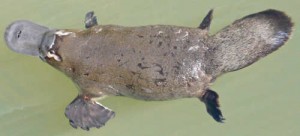 Personally, I think the term duck feet is a bit unfair on ducks. Ducks don’t actually have turned out feet. They just have flat feet and legs that are spaced widely apart.
Personally, I think the term duck feet is a bit unfair on ducks. Ducks don’t actually have turned out feet. They just have flat feet and legs that are spaced widely apart.
I tried to think of any animal that actually has out-turned feet and really struggled (if you can think of any, let me know). The only one I could think of was the Platypus and its legs are more like flippers anyway.
Therefore, unless you’re a Platypus (or have a structural problem), your feet should be parallel with each other and pointing straight ahead.
Ok I am rambling, back on topic…
So I have duck feet, so what?
Many people don’t consider duck feet a problem. At first glance it may not seem to be that big a deal. The truth is, out-turned duck feet is the postural equivalent of having a flat tire.
Unfortunately, its also incredibly common.
Next time your strolling around the area you live in, take a look around you. You will notice that a large percentage of the population sit, stand, and walk with a foot or both feet rotated outwards. If it’s one foot, its nearly always the right. If its both feet then its nearly always a man.
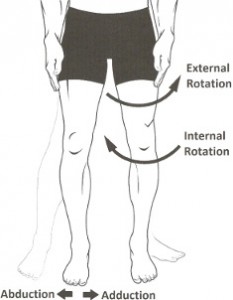 Before we break down what’s happening in specific areas, I think it’s important to look at the body as a whole. Turning a foot out, causes the arch to collapse slightly. The further the foot turns out, the flatter the foot.
Before we break down what’s happening in specific areas, I think it’s important to look at the body as a whole. Turning a foot out, causes the arch to collapse slightly. The further the foot turns out, the flatter the foot.
Whenever we walk, run, jump or squat, our bodies work very hard to prevent or decelerate the collapsing in of our leg and foot arch. The problem with an out-turned flat foot is that it makes it harder for our bodies to accomplish this.
As you will read in the sections below. When a flat foot hits the ground, or when the knee internally rotates or adducts to far, bad things happen.
If we look the anatomy of the leg and hip, we can see that the body is put together to help protect us against this.
When our foot hits the ground, our Gluteus Maximus and Medius (bum muscles) work like breaks to decelerate the collapsing inwards of our leg and the flattening of our foot arch.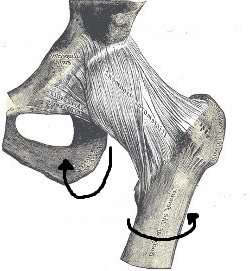
If we look deeper, we can see that the fibre orientation of the hip capsule is designed to help with this. This is complex but, it works like this; when the Glute muscles contract, the femur externally rotates and a posterior rotation force (backwards tilting) is applied to the pelvis. This tightens the hip capsule and draws the head of the Femur deeper into the socket. This increases the stability of the hip joint.
At the knee, we can see that the cruciate ligaments (see section below) are positioned with a similar aim in mind. When the Glute muscles contract, an external rotation force is applied to the upper leg. If the foot is facing straight ahead, then this tightens the knee joint.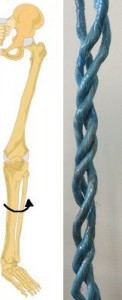
Our bodies also have four muscles at calf level that work to help maintain the arch of our foot (See reduced shock absorption below). The whole system, from foot to hip, works like a tightening rope. Turning the foot outwards loosens the rope, this leads to instability and possible increased wear and tear on the joints.
When it comes to movement, turning the feet out makes it is more difficult for us to recruit the correct muscles. Our bodies therefore, have to rely on other muscles and the elastic structure of our ligaments & joints. After a while these structures get pretty pissed.
From a performance point of view, turning your feet out is also inefficient. It’s a bit like driving a car with flat tires and the wheels rotated out. You’ll get pretty crappy mile per gallon and the chassis will get wrecked.
The following sections break down the effect that duck feet have on individual areas of the body.
The effect on your ankles and feet
Refused Shock Absorption
The arch of the foot is designed to provide shock absorption when walking, running and jumping.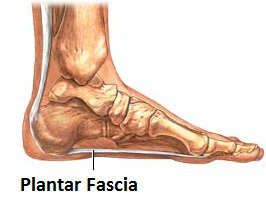
When a foot is flat, the Plantar Fascia becomes lengthened. The Plantar Fascia is a band of connective tissue which helps form the arch of the foot. It works like a bow string connecting the toes to the heel bone. People with flattened arches often suffer with pain on the sole of the foot. If you have ever injured it or suffered from Plantar Fasciitis you will know how incredibly painful it can be.
There are also several muscles that also work to help support the arch of the foot. When the foot is rotated outwards, the arch is flattened. This puts these muscles into a lengthened position. These muscles now also don’t have to work as hard as more of the foot is now resting on the ground.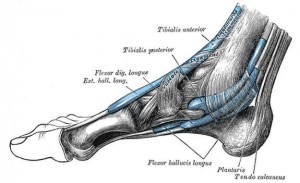
Muscles don’t react well to being constantly lengthened and unused. The Tibialis Anterior, Tibialis Posterior, Flexor Hallucis Longus & Flexor Digitorum Longus all become weakened and effectively shut down. Ever felt that pain up the front of your shin when running? It’s probably your Tibialis Anterior crying as it tries to cope.
We are now left in a situation where the foot has lost its ability to absorb shock. The shock created when walking, running and jumping is therefore, transferred up through the rest of the body.
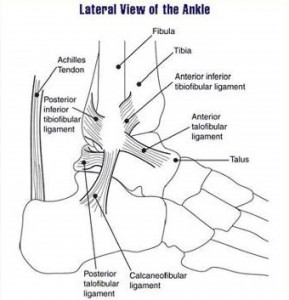 Ankle Stability
Ankle Stability
Turning a foot outwards loosens the ligaments on the outside of the ankle (the lateral ligaments). Ligaments form our joints and help hold our bones together. If you have ever twisted your ankle, you will know where the lateral ligaments live (ouch!).
The fibula is a small long bone that runs up the outside of your shin. The lateral ligaments join the fibula head (your ankle bone) to your foot. When these ligaments become loosened, they effect the alignment and stability of the fibula and ankle.
Moving On Up
The other end of the fibula is connected to the shin bone by the lateral collateral ligament (LCL). The LCL helps stabilise the outside of your knee (see image below). Therefore, standing with your foot rotated outwards, can actually compromise the stability of the ankle and knee.
The effect on your knees
Medial Collateral Ligaments
As I mentioned above, an out turned foot can effect the LCL. The ligaments that provide stability on the inside of the knee (the medial collateral ligaments/MCL) can also be affected.
When the foot is rotated out, the MCL is put under constant tension. If a sudden load is put through the knee in this position, the ligament can tear.
The MCL also attached to the Meniscus which is one of the two horse shoe shaped shock absorbers deep in the knee. The Meniscus also helps the bones in our knee glide properly.
If the MCL is under constant tension is can lead to increased wear and tear of the Meniscus.
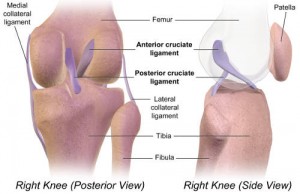 Cruciate Ligaments
Cruciate Ligaments
As mentioned at the beginning of this article. Inside your knee, you have two ligaments called the Anterior and Posterior Cruciate Ligaments. They form a cross deep within the joint which helps to hold your upper and lower leg together thus providing stability.
Remember the tightening rope analogy? Turning your foot out unwinds these ligaments like a rope unwinding. This decreases the stability of the knee joint.
Some sports require people to turn their feet outwards. For example, snowboarders and surfers usually turn one or both feet out. The same is true of some occupations. If you are a soldier you will probably spend a decent part of your life standing in the ‘at ease’ position. In a lot of countries this means your have to stand with out turned feet.
The instances of anterior cruciate ligament damage in both the examples above is very high indeed. Tearing the cruciate ligament can even be be career ending in some cases.
The effect on your hips and back
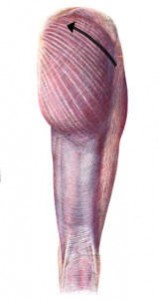 Turned Off Glutes
Turned Off Glutes
The Gluteal muscles have many roles in relation to movement. In addition to their role as movers, they also play an important stability role. The Gluteal muscles help to stabilise the pelvis, this in turn, helps to protect the lower back.
If you squeeze your buttocks together you may notice your abdominal muscles contract slightly. This happens because, when your Glutes fire up, the rest of your body takes it seriously. The body perceives a load is on it’s way and switches your abdominal muscles on to help protect your spine.
During movement, the Gluteal muscles help to prevent/decelerate adduction and internal rotation of your leg. This in turn, helps maintain the arch of the foot. Without this breaking action, everything collapses.
Turning the foot out reduces our ability to recruit our Glutes. Try the following:
Stand up with your feet at hip width and your toes pointing straight ahead. Squeeze your buttocks together and try to pull the floor apart using your big toes (imagine trying to stretch the floor between your feet). Now relax, turn your feet out and squeeze and again. You will notice that its a lot harder to contact your glutes and pull the floor apart with your feet like this.
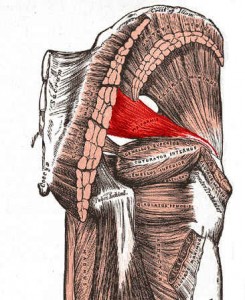 Shortened Piriformis
Shortened Piriformis
The Piriformis is a small muscle that crossed from your sacrum (the triangular bone at the bottom of your spine) to the tip of your femur (the upper leg bone). When you turn your foot outwards, this muscle is put into a shortened position. If you spend enough time in this position, the body decides that this is it’s normal resting length. The muscle simply shortens as it is only every required to work within this small range of motion.
As mentioned above, with the foot turned out, the Glutes can’t function as effectively. The body therefore has to find other ways to help prevent/decelerate the collapsing in of the knee and foot arch. It accomplishes this by getting Piriformis (amongst others) to help out.
Now, Piriformis is only a little muscle and its not designed to do this. It therefore, gets annoyed with having to do so much work when its already in a shorten position. The muscle becomes hypertonic (stiffer) and can end up pressing on the Sciatic nerve.
Spinal Alignment & Leg Length
As already mentioned, an externally rotated leg causes the arch of the foot to collapse which effectively shortens the leg. The body now has to compensate for this up through the rest of the system.
If someone has a shorter right leg, their pelvis will tip forward on that side. Often, that side of the pelvis also shifts forward (one side of the pelvis is further forward than the other). This rotates the entire pelvis to the left which can even effect the muscles in the opposite hip.
The Lumbar spine (lower spine) now has to rotate slightly to the right and flex to the left to compensate. Moving on up, the Thoracic spine has to rotate slightly to the left (relative to the Lumbar spine) and flex to the right. This process continues all the way up to the head.
All of this creates an acquired Scoliosis (see here) and can even effect shoulder height.
Identifying the site of rotation
The first step is working out where the rotation is happening. Is the external rotation occurring at the hip or below the knee? Working this out is tricky and will require the aid of a therapist or coach/trainer who knows what to look for.
A Therapist will probably use ‘Craig’s test’ to check the alignment of the head of your femur (The top of your upper leg bone). ‘Craig’s test’ can be useful when trying to identify Femoral Retroversion (see video above). It is possible to perform the test on yourself laying on your front using a mirror. However, performing ‘Craig’s test’ on yourself is pretty tricky and not particularly accurate (believe me I’ve tried). Therefore, your best bet is to see someone qualified who can perform the test for you.
 Once Femoral retroversion has been ruled out, we can check the alignment of the knee. When standing, your knee cap should be roughly in the centre of your leg. If your knee cap is turned out, the rotation is probably occurring at the hip. If the knee cap is in the middle and your foot is still sticking out then its probably happening in the lower leg. When you have worked out which joint is out of alignment, we can identify which muscles are affected.
Once Femoral retroversion has been ruled out, we can check the alignment of the knee. When standing, your knee cap should be roughly in the centre of your leg. If your knee cap is turned out, the rotation is probably occurring at the hip. If the knee cap is in the middle and your foot is still sticking out then its probably happening in the lower leg. When you have worked out which joint is out of alignment, we can identify which muscles are affected.
With this in mind here is a quick break down.
If the problem originates at the hip, the Femur will be externally rotated. The rest of the leg just comes along for the ride and turns out with it. This means the Piriformis will be shortened and over active. The Gluteus Maximus will also be shortened but under active due to the Piriformis doing most of the work. The back of the hip capsule may also be shortened.
When the problem starts below the knee, it’s the shin bone that is externally rotated (relative to the Femur). In other words, the leg is tuned out from the knee down. Again, bone abnormalities can be a factor of this (see congenital below). If this has been ruled out, a short/stiff Bicep Femoris (one of the hamstring muscles at the back of the upper leg) can be one of the causes of this. Typically, the muscles on the outside of the shin will also be shortened and the muscles on the inside lengthened.
A limited ankle range of motion can also cause us to turn a foot out. We need a minimum of 10-20° of ankle dorsiflexion (shin moving towards the foot) to be able to walk and run properly. If our calfs get short, or our ankle joints become stiff, then our bodies have to find a way to work around the problem. How do our bodies do this? You guessed it, we turn the foot out and collapse the arch to go around the restriction.
Why do I have turned out feet?
Like many postural problems, flat out-turned feet can be split in to two main categories.
Congenital: Something you were born with.
Acquired: Something that has developed possibly due to; injury, disease or behaviour.
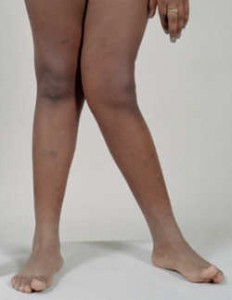 Congenital
Congenital
All of us are born with flat feet and as children, we usually, also have slightly turned in knees. As we grow, everything slowly tightens up and rotates out. The femur and lower leg externally rotate and the arch of the foot is slowly lifted.
Out-toeing is actually pretty rare in new-borns. Having said that, we can be born with abnormalities such as ‘Pes Planus’ (flat feet), ‘External Tibial Torsion’ (twisting outwards of the shin bone) or ‘Femoral Retroversion’ (a turned out femur). A leg length discrepancy can also cause us to turn a foot out. Problems like these don’t always self-correct as we grow.
Some problems can develop as we grow. Most of us get tighter as we get bigger, it’s just a normal part of child development. Sometimes though, children grow at such a fast rate that its difficult for their muscles to grow as fast as their bones.
This can lead to problems such as bowing of the shin bones or Osgood Schlatter disease. These conditions can also cause the feet to turn outwards. Technically, I tend to regard these problems as ‘Acquired’ rather than ‘Congenital’ as we are not born with them. It just it made sense to include this information in this section to help the article flow a little better.
In any case, a good therapist should be able identify these problems for you.
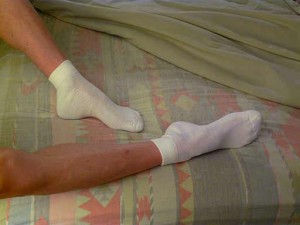 Acquired
Acquired
In some cases, the problem may have originally been caused by an injury. If the injury was chronic (it lasted a long time or reoccurred) a person may have compensated and turned their foot to avoid the pain. After the pain has abated, the person may have been left with the compensation (i.e. an out-turned foot).
As already discussed, having out-turned feet puts some of our muscles and ligaments in shortened or lengthen positions. One question I am often asked is, “Did my foot turn out because my ‘insert muscle here’ is short or did my ‘insert muscle here’ get short because I turn my foot out?”. To be honest, it’s a bit like which came first the chicken or the egg, who knows?
In my opinion, most of the time our out-turned feet are the result of our behaviour and life style. If we habitually turn a foot out, our bodies just adapt to the behaviour. Muscles tighten or lengthen and our joints adjust. Eventually this just feel comfortable to us. Turning the foot back where is should ends up just feeling awkward as the position has become alien to us.
A lot of us subconsciously turn our foot out during certain tasks. The following list is based on my own observations.
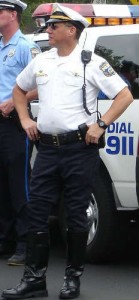 Our Job or Kids: Many of us have jobs that require us to stand for prolonged periods of time (i.e. hairdressers). A lot of us end up shifted our weight on to one leg. Standing in this way actually burns less calories. The strain goes through the IT band and the lateral ligaments and our muscles don’t have to work as hard. Humans are pretty lazy creatures. As our stability has now been compromised we often turn a foot outwards to create a kind of false lateral stability. This also often happens when mothers carry a child on one hip.
Our Job or Kids: Many of us have jobs that require us to stand for prolonged periods of time (i.e. hairdressers). A lot of us end up shifted our weight on to one leg. Standing in this way actually burns less calories. The strain goes through the IT band and the lateral ligaments and our muscles don’t have to work as hard. Humans are pretty lazy creatures. As our stability has now been compromised we often turn a foot outwards to create a kind of false lateral stability. This also often happens when mothers carry a child on one hip.
A Bigger Foot: 80% of us are born with our left foot bigger than our right. Just like the above example, perhaps we shift our weight to the bigger foot as it has a bigger surface area. I don’t have any evidence for this it’s just an idea that makes sense to me. This may answer the question of why it’s usually the right foot that’s rotated outwards.
Shoes: As mentioned before, when the calf muscles get short, we tend to turn our feet out. Many people are surprised when I tell them that they are shortening their calf muscles all day due to their type of shoe. Now, I’m not just talking about high heels here.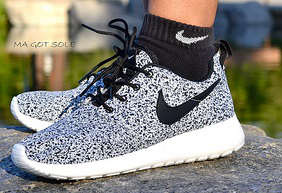
Nearly all modern footwear has a bit of a heel even if it’s just ½ an inch or so. Running shoes are particularly bad as the heel can be as much as 1½ inches higher than the toes. Running shoes are designed this way to help reduce shock when we run. However, as I mentioned above under the heading ‘Reduced shock absorption’ our foot and ankle have muscles that are designed to absorb the shock. Wearing highly supportive shoes or footwear with a heel (no matter how small) leads to weak feet. This again, means we are more likely to turn them out.
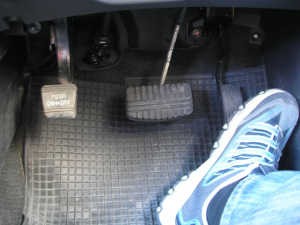 Driving: The position of the pedals and shape of the footwell in cars makes it more comfortable to turn the right foot out.
Driving: The position of the pedals and shape of the footwell in cars makes it more comfortable to turn the right foot out.
Habit: Crossing our feet when sitting or laying just out of habit.
Social: Simply choosing to turn a foot out when standing or sitting to show people we are relaxed.
Manspreading: This has been in the press quite a lot recently. If you haven’t heard of it, it describes that irritating guy who sits with his leg apart thus taking up three seats on the subway.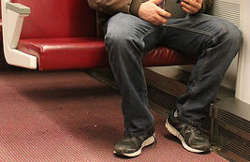
Standing with the feet turned out is the standing equivalent of this. At first glance, many would guess that men turn their hips/feet out out of ego.
“Hey girls! Look how much space I need to create down here.”.
For some guys I think this does ring true. Personally though, I think there may be more to it that that. Perhaps men do this to help with temperature regulation of their twig and berries. After all, its all on the outside for a reason.
What can I do about it?
If it’s a congenital problem then there honestly isn’t a lot you can do about it. Well, not without a hammer chisel and a serious amount of pain killers! You simply have to find a comfortable compromise between ankle, knee and hip alignment.
If the problem is acquired then there is a lot more you can do about it. I am not going to lie, fixing this isn’t easy. Firstly, you need to identify your bad habits and quit turning your foot out. Chances are, there is more than one bad habit that has lead to the problem. Don’t be a Platypus! Check your foot position when standing, walking sitting and laying. Actually, look down right now and take a look. How’s your foot position?
Try to keep both your knee and foot facing forward at all times. Don’t rotate your foot in so much that your knee isn’t central. Its simply not worth sacrificing your knee to keep your foot straight.
Once you have got rid of the cause, you need clean up the mess that is left over. This can be achieved by working on your mobility and movement. Once its restored it’s much easier to maintain a good foot position. As this article is already too long I am not going to go into this here. Search for ankle mobility drills and stretches on the web and you should find an abundance.
In my own case, both of my feet used to stick out. Ditching the expensive running shoes and switching to flat footwear made the biggest difference. I then made a conscious effort to avoid turning them out. That and a bit of Piriformis and lateral calf work pretty much fixed it for me.
As always, if you are concerned about your health and posture, go and get yourself checked out by a professional. If you found this article useful, please throw me a bone and share it with others.

When I was born in 1963, the doctor immediately put my legs in a brace to correct my ( duck feet) but they still stick out. I lived in Minnesota and constantly got teased the way my boot tracks looked in the snow. I have always worn out the outside heel of my shoes.
Was pain free my whole life but now at 61 ,both hips are giving me trouble ( arthritis). A physical therapist took a look and guessed the brace used when I was born bent my femoral neck ( area between femur and ball. Wondering if total hip replacement (both hips) would possibly be effective now that my knees, ankles & feet have adapted to my feet sticking out?
Without knowing the degree of pain you are in or viewing x-rays it is difficult to give specific advice. As you say your knees, ankles and feet will have adapted to compensate for your toes-out posture. Typically these compensations are not optimum and can cause problems with various ligaments and cartilage. Regarding surgery, in general terms, I would expect a total hip replacement (if done correctly) to actually slow degeneration in your knees and ankles. However, this is highly dependent on the suitability of the implant used and the quality of the surgery. There is also the question of how much the problem is impacting your life and whether the cost of the surgery post-surgical recovery time required is worth it to you. Hope that helps
IT’S DEFINITELY NOT TRUE that “a large percentage of the population sit,stand and walk with a foot or both feet rotated outwards.If it’s one foot, its nearly always the right.If its both feet then its nearly always a man”!THESE ARE SIMPLY NONSENSES!NO,THERE ISN’T ANY “large percentage of the population that sit,stand and walk with a foot or both feet rotated outwards”,but ONLY SOME PEOPLE and their percentage CERTAINLY ISN’T “LARGE”,so THIS CLEARLY ISN’T “incredibly common”,but PRETTY MUCH UNCOMMON!Also,when it’s one foot IT’S NOT “nearly always the right”,but THE LEFT AS MUCH AS THE RIGHT and when it’s both feet,MOST OF THE TIME IT’S A WOMAN AND NOT A MAN!ANYONE CAN TELL YOU THAT!So much for your “observations”!And,anyway,DUCK FEET ARE NOT SUCH A PROBLEM and THEY OBVIOUSLY ARE NOT “TRASHING YOUR BODY”!Besides,NOT EVERY FOOT(OR FEET) that it’s turned out it’s a “duck feet”!ONLY FEET THAT ARE SERIOUSLY(AND PERMANENTLY) TURNED OUT can be called like that and THERE ARE A LOT OF TIMES when standing(NOT sitting,because when you sit YOUR FEET CAN BE TURNED OUT AS MUCH AS YOU WANT without any problem!) with the feet or with one foot turned out IT’S NORMAL AND THE NATURAL POSTURE OF THE BODY and,therefore,IT’S EXACTLY THE WAY IN WHICH ONE SHOULD STAND!HUMANS ALWAYS WALKED,SIT OR STOOD WITH THEIR FEET TUENED OUT(more or less) and THIS POSED NO PROBLEM FOR THEM!So,STOP WRITING ALL THIS HUGE RUBBISH which ONLY TORMENTS AND CONFUSES PEOPLE and WAISTING OUR TIME with it!
Got caps much. Ugh, ease up. You come across as very childish.
What’s your problem with caps?!I use them AS MUCH AS I WANT and THIS IS REALLY NOT YOUR BUSINESS!YOU SHOULD EASE UP because YOU ARE THE ONE who “comes across very childish” by telling people IMMATURE AND TOTALLY IRRELEVANT THINGS!
every article i’ve read about SI instability/ injury points 1st to pregnancy/child birth.
I am doing the egoscue exercises and using the egoscue tower. Any advice on if this actually works or helpful for aligning hips. I have legs turning outward and also knees and feet. Interested if anyone has used the egoscue method and if it helped.
The Tower helped me. I got out of the habit of using it, now do hip flexor stretch daily.
I got here looking up information on ‘foot injury can throw hip out too.’ .What an article; it is among the very best I’ve ever seen on the internet Style, voice, tone and details and just see how well the commenters respond. Here in Hawai’i see examples of congenital birth effects on legs of adults and children. Bowed legs are so common among certain groups of people as to seem nearly universal. It seems that the majority of women in one group are born with them. But men of the same group can also have the bowed legs. Maybe diet of mother from womb.
great work.
Thank you for the write up. I will search for the ankle mobility drills and stretches and keep an eye on how my feet are pointed.
I will find the ankle mobility drills and stretches. I will try some flat shoes instead of the running shoes. And I will watch my feet. Thank you.
The video you posted in your article very explicitly states *not* to instruct people to “keep their knees straight, or point their toes forward.”
Do you, as the writer, disagree with this part of the video?
I can only believe that most readers will assume that you are telling them to try this without further examanination.
**I was wondering if you could please provide some links to articles/references that influenced this article so that I can research into it further.**
Thanks for your great article. I’ve had constant pain for many years (starting in my middle teens) in my hips, lower back, knees etc. I’m not even 20 yet and I used to be a very athletic person- and now I can hardly walk without pain. I have been to multiple health professionals and gone through numerous exercise programs they thought might help- they never found anything to explain it and just told me my muscles were ‘tight’. Upon my most recent visit to another exercise physiologist he discovered my right foot points out a little. So I started googling and came across your article. Every single symptom that was pointed out- the sciatica, potential for a shorter leg due to fallen arch, asymmetrical hips because of this…lines up with everything…It was amazing to finally feel I found something that sounded like me!
I was wondering if you could please provide some links to articles/references that influenced this article so that I can research into it further. I will most certainly continue with the exercise physiologist- by no means am I disregarding health professional advice- I would just appreciate being able to understand it for myself.
Again, thank you so much for your article..I’ve been having a terrible time being so young and having all this pain and no answers. Now I finally feel like I might be on the right track.
Any luck figuring out what was causing your pain?
Great article, i just wonder why mothers aren‘t mentioned? I can almost pick who has had children based on the fact their feet turn outwards. It fascinates me that all of these pregnancy related conditions aren‘t all looked at in a post natal health check like a car check basically! All of these ailments after giving birth are all discovered by mums ‚as they go’ as they never knew about these things beforehand like muscles switching off like TA, PF, glutes; outward turning feet; prolapse; ab separation, and ensuring proper alignment would help much of these ailments. It‘s endless the list and all could be addressed during a proper thorough health check with a physio/GP
This is so true!! Post partum mom here, and my legs turn out now! My hips are wider too. So frustrated to not find anything on the internet about this. I would like to know exercises to help get my legs/hips aligned again.
when i turn my feet straight my knee caps are turning in and it stresses me at hip level to keep my feet straight( also it would give me knock knees ) I have been spreading my feet since i can remember so either i acquired it in childhood or am born with it. does this fall on no remedy or is this workable and will an orthopedic just laugh at me for that?
I had an acl operation in 1984 dr. david dandy it never “worked” since then & it is giving me extreme pain & my left foot is turning more outwardly. ihave special shoes but if there is any chance to improve it I would like to consider it. CAN YOU HELP PLEASE.
DAVID
sometimes I get made fun of because of the way I walk quite annoying actually
I had a hip arthroscope on my left hip earlier this year. Afterwards my balance was off. More recently my right foot (non op leg) turns out when I walk. So badly that I can’t straighten it and if I do I end up walking in my tippy toe. I feel I have no control over it and if I make my foot straight it is difficult to walk. Any suggestions as to what might be happening?
An ER doctor told my parents when I was 10 that I needed corrective shoes as my ankles turned my feet out. Needless to say my parents did not move forward with corrective shoes. Is it too late now? I am 76.
A Basset Hound has the outward pointed feet you were looking for.
Hey, great article. Very detailed and informative.
Just one question though. In the Turned off Glutes section You say : “Turning the foot out reduces our ability to recruit our Glutes.” Could you explain this a little more as I would imagine that as the glute max is an external rotator of the femur it would be constantly on, just like the piriformis and the other deep lateral rotators of the hip, gemelli, quad fem etc.
Is it because it is already shortened?
Thanks in advance.
Basically, yes. Try to do the test mentioned in that section and you should be able to feel you can’t get as strong a contraction with your feet turned out.
I have a 16 year old son with a disability who’s right foot is turned out badly. It greatly affects the way he moves. We have tried many techniques and braces. Do you know any where that makes a foot brace that holds the foot straight? He does not understand the concept so can’t correct it himself…
My feet turn outwards and I walk on the lateral side of my feet, but my arches are high and I have a 1cm tibial leg length discrepancy. I had PF once in the shorter leg (left leg) after a course of prednisone in which I could not get any shoes on my feet except some flip flops and so I walked around in those for 6 weeks. Podiatrist at that time immediately claimed, without observing my gait, that PF meant over-pronation and put in orthotics for that purpose. Long story short, she destroyed my feet and my gait. Now I suffer from piriformis and am wondering with arches yet out-pointing, should I be wearing any arch support inserts right now? The insoles she had me in caused peroneal tendonitis in my right leg, and the physical therapist I saw last year doesn’t think I should be using arch support. Too many conflicting opinions, while I sit, stand and walk in pain. Heel lift of 3mm for shorter leg makes things worse instead of better so I gave up on that.
Any type of shoe lift has to go Under shoe. The entire length of shoe. Regardless of height. Because that throws off the arch by putting inside shoe.
I wish this was an Easy Fix. My left foot is inverted and twisted tibial torsion. Then my right foot is exverted or outward rotated. I have a Hip Impingment. And a Bad gait. I’ve been told to try and Correct my feet every step. And use cane. That isn’t easy. Doctors say well you have been walking like this for 30 years. It’s probably going to take at least 15 years to get Better at Walking. Idea is Don’t Give UP.
The more you move the better you are. Surgery isn’t the Answer for me. I’ve read so many interesting stories and I hope everyone finds answers. The Dr wants me to get Orthopedic Inserts for shoes. Truth is that’s 300.00 I can’t afford. I have a Bad Muscular Problem. I’ve been fighting this for years. But it ALL starts at the FEET.
You have to have a GOOD home Base. Firm Foundation. Balance is a Must Have.
I’ve Learned so much from this Page. Thank You. God Bless
I had a total hip put in 28 years ago. I’m thinking it is off center some where it makes my foot point outward some. It feels natural to have foot outward some. I think if Dr would have turned thigh little more inwards. I wouldn’t have to force my leg to turn straight. Therefore I could use my glutes. It has taken me this many years to come to this conclusion.wish me luck. I hope to one day be able to Stand on my right leg. And get my Periformis to Settle Down. I’ve had SI injections. I just want to get this Tork figured out. My pelvis is Tilted. This throws off everything. Plz pray. Thx
My son and husband both have this problem. They also both have autism. My son doesn’t feel pain as much as most of us do so when he is in pain I know that it could be bad. He has been limping for about two months and saying he is in pain right above the left ankle. I took him to see the doctor and he has referred me to an orthopedic doctor at Shanes, which is a big time hospital. I haven’t seen them yet but I am nervous about them doing surgery on him. He is 17, 6’3” and he loves to run. I have noticed that his feet have turned out more and more through the years. He also was born with hypotonia. But a doctor when he was 9 told me he no longer had it just had really weak muscles. When he sits his feet are turned so bad that they make a straight line. And when he lays down they do the same. Sorry about writing so long but I just want to know if surgery I possible good option here. Do I have to worry about it. I don’t want to make the wrong decision.
Hey ! I have the reverse problem : my left foot is rotated inward while the knee cap is facing (from what I can tell in comparison with the right one) outwards. Is that common ? Should I address this problem the same way as the feet facing outwards ?
Thanks !
My feet have always turned outwards slightly. I have a sister and brother whose are the same way. I’ve had foot problems all of my life. They hurt badly after standing for even a short period when I was young and of course much worse now that I’m older. Also l have another sister, and two daughters, whose left feet turn somewhat inward. I never knew if this could be corrected.
I am female and both of my feet point out when I stand, walk and when I lie down. It’s not so bad when I stand and walk, but when I lie down, the outer sides of my feet actually touch the bed. I have no pain or problems from it, I just thought it was kind of weird and decided to Google it. I guess I need to start working on it, although I’m still not exactly sure what to do. I can consciously correct it when I walk, but when lying down, I can only hold my feet straight for a short amount of time before my muscles start hurting. Then I go to sleep and they turn out anyway.
Same here.
I too have this problem. When sleeping sleep on your side. Put a pillow between your legs and hug a pillow. This aligns back and seems to help the duck feet too. Helps me so I hope it helps you.
Egoescue exercercises should help
I too was looking for more specific information on how to fix or help alter the toeing out. Discouraged to hear not much can be done. But any possible treatment ideas would be good.
Can walking with one really turned out foot and the other one slightly turned out (for 80 years now…) cause, or contribute to, swelling of the ankle and foot?
hi – my 27 year old daughter was born with slightly odd hips – I’ve forgotten the term they gave them – but it meant she had slightly weak ankles and her feet rolled over to the sides a bit – if you kn ow what I mean – nowadays the shoes she wears are more worn on the outside of each foot and more pressure has been applied to that bit !! anyway she had to wear little leather boots till she was about two and then do ballet and they said the outward movements would help her !! she had no further bother with that thing but now she is an adult she has v bad problems with her spine, neck, wrists, knees – generally everywhere achey and stiff –
she has had numerous tests – x ray etc and nothing shows up – over th past five years she has had a lot of stress in her life – my husband/her father died two years ago v suddenly and other traumas so she feels worse – a lot of it is stress related but a chiropractor and osteopath both say her chest is badly knotted up too – I have a feeling the problem may stem from this childhood thing with her feet – I just don’t know where to tell her to go for help – the doctors are useless – have tried, chiropractor, osteopath, shiatsu etc etc – any ideas please would be gratefully accepted !! she is 6 feet tall, works with her hands and plays an accordion in a rock band so has a lot of muscular stuff going on – also she stoops a bit but I still feel it comes from a foot prob !!!!
Hi Susan,
I have a client that is a 30 year old female, quite tall, but had so much stiffness and achiness in joints. She told me she felt like a 90 year old woman. We started training together 6 months ago, about 3-4 times per week (started off at 2-3) and I would do a variation of postural work, yoga/stretching, and muscle strengthening. She also had chest issues and reduced lung capacity/shortness of breath issues. Within about 4 months, she became a brand new person. Her bones stopped aching, her posture completely changed, and she feels better than she ever thought she could. I believe what you’re saying- physical body issues can be a manifestation of emotional/mental issues that will show up later in life. The body is very intelligent. You need to find someone who has a great awareness of the body, who can help your daughter to heal, while at the same time, help her to become strong and challenge herself in a fun, safe way. What I have seen with my clients is nothing short of a miracle. New lease on life, whether they are 20 years old or 75 years old. I hope this help you xo.
Susan has your daughter been checked for Marfan’s or Ehlers Danlos Syndrome?
looking for tips and advice for my 10.5 year old daughter, She is active playing tennis now, previously did tumbling and cheer and gymnastics but she has always had an issue we can’t seem to overcome. With her feet turning out (out-toeing) when she runs which diminishes her ability to do all the sports in a competitive fashion, because she is not running properly. When she tries to put her foot straight ahead, her knee then curves in. When she was a baby she was seen by a pediatric neurologist that she had positive Forster’s sign, her hips were completely flexible, she was doing straddles and could put her leg over her head with no pain. They told us to start PT which we did for about 8 mo. – she was a very late walker at 18 mo. because her hips could not support her on her feet. Fast forward – she is walking fine but her feet are extremely flat and I noticed when she would run in cheer at age 7 she was out-toeing and she landed her handsprings with her feet turning completely out. She had trouble running to the Pommel too, so we quit cheer, tumbling and gymnastics and now moved to tennis. I have been to an orthopedic doctor about 1.5 years ago and he examined her and said she was within “normal range” limits and sent me away. I am so frustrated with this, so what are my options to fix this? She wants to be athletic but her feet get in her way and she is limited to improve with this condition. Telling her to just try hard to walk with her feet straight feels weird to her as her knee moves with her foot. Can this be fixed?
Hi Valerie,
I realise many years have passed since your initial comment, but was wondering what the outcome was for your daughter? My son is 9yo, very active in sports but seems to be a bit limited due to out-toeing. Ironically, we have been seeing a chiropractor to deal with a misaligned neck. It’s only now that I’ve been able to connect all the dots.
All the best
I’m a very kinesio-conscious person and still couldn’t get this “fixed”. All my life I’ve had this sense of not being able to dorsiflex one ankle as well as the other. When I finally went to an orthopedist about it, I was told I had arthritis and that a fusion would be in my future. This was at 30. I got an alternative treatment (distraction arthroplasty) which has helped some, but now I know my posture and back issues relate to something I just cannot change. Flat running shoes have helped a lot, but my doctor says the ankles are really just getting messed up a different way when I wear them.
Both my feet are everted and I’m pretty sure I got it from driving. Both my feet wanna be the exactly the same way as when I’m sitting on my car, which is the left a little everted and the right aloot.
Gotta be it, right?
I must fix this asap, since the way I walk is hurting my right feet.
As you said, first thing would be to always stay with both feet same way as the knee, pointing straight, right?
In general lines, what else could I do? calf stretch? Please point me to the right direction to fix this. Can’t see a doctor
Something people need to address is WHY they are looking at their posture. I’m a registered massage therapist and ‘posture’ is shoved down our throats in school as the #1 leading cause of pain. Ex. Neck and shoulder pain because your shoulders are rounded forward, or low back pain because of pelvis rotations etc. I can say through my experience, posture plays much less of a roll in pain than once thought, and there is a mound of research coming out these days to support that. Bodies are adaptive, if you’re naturally toeing out, and have since you were young, your body is aware of this and ligaments will adapt. The vast majority of people have slight toe out, or pelvis rotations, or flat feet etc and can all live happy pain free lives. But according to articles like this they should pretty much all be in pain? Posture can have a roll in pain, but don’t go looking for problems just because of a normal postural variance. Forcing yourself to parallel your feet can actually wreak havoc on your body – especially under load – if it’s not something your body is used to. Everyone is different, I haven’t seen a ‘perfect posture’ in my years of practice yet 😉
Personally, my body never adapted and is asking me to change sending me messages through pain every day.
From my experience posture has the most important role and even the slightest variance can cause problems
Hi, thanks for this. My hips are very turned out due to ballet. Didn’t realise this is a problem.
Me too it seems I did ballet for 10 years, my mom walks duck style too so for me Between ballet and perhaps following my mom here I am almost 40 years old & I really want to change posture. I had 2 c sections ehich I believe is due mostly to poor posture / hip space etc- they each settle on the opposite side of uterus
Making it so they would have to turn 270 degrees instead of 90 degrees during birth.
If there is no pain, there is no problem! Bodies are adaptive and resilient, and just because your hips are externally rotated doesn’t mean it’s an issue.
True Brock, BUT, if there is pain, this is a very informative article which helps explain where it MIGHT be coming from. And there is not a lot of info out there about this issue. I’m an acute care NP and this is a great read.
This has helped me a lot as a kid I used to get sore knees to a piont I couldn’t walk but still had to go to school. I always wondered why my kneed turned in and my feet would face out. I have tried walking with my feet straight but it is very uncomfortable. Reading your article has made me realize all my problems are caused from how I walk. Thanks you very much for posting your article 🙂
Rocky – so how did you fix your situation? Do you walk with your feet parallel? or walk with out-toeing? Are you able to run – with speed?
Incredibly helpful article. I’ve been struggling with a few seemingly unrelated issues and making efforts to correct each separately with mixed success. Your article was the first I’ve seen which successfully tied some seemingly related issues (long sedentary periods, poor posture, tight hips, poor running speed, some knee pain) together in a clear and meaningful narrative. Thank you for publishing your research and analysis on this. Very grateful.
21 years ago I had an accident that crushed my body (vertically). For a brief while I was 2 inches shorter. I was an athlete, so once I had ‘recovered’ I tried to get back to running but kept getting a tear in my right calf. I was diagnosed as having a right leg that was now anatomically shorter than my left, and was given a heel build up. But over several years I just picked up more injuries – you name it, I had it. Eventually I was told that, no, you have been misdiagnosed, you have an “apparent” not “actual” shorter leg, so I abandoned the orthotics but by now the damage was done (they caused grade 3 arthritis in the knee, plus a tear) . When I stand upright my right shoulder is lower than my left, but it’s clear that this is coming from the hips. When I lye down, my right leg falls to the side. A couple of years ago I saw a back therapist who deep massaged my back, hips and buttocks. I couldn’t believe the difference when I stood up – I felt like my right leg had grown six inches. And lying down, no longer did my right leg fall out. Unfortunately this only lasted a couple of days. Any attempt to have the said areas massaged again did not yield the same positive result. My GP is now talking about an operation, but I would much prefer to find an alternative solution.
I don’t often reply to questions asked here as I am very limited time wise and it’s pretty impossible to diagnose over the net. This misdiagnosis is however, something I come across frequently. My advice would be to see a good physical therapist who can diagnose the true cause of the apparent leg length discrepancy. Is one innominate (one side of the Pelvis) in anterior or posterior tilt relative to the other? Is there an upslip or a flare? At some point I will write articles that explain each of these problems.
Once diagnosed, they should be able to correct the problem via soft tissue work or a manipulation. If the problem reoccurs then it’s important to identify lifestyle factors and bad habits that could be causing the problem to reoccur. For example, sitting with one knee up or crossing the legs can cause a posterior rotation of one innominate relative to the other. Get them to explain to you physically whats going on then try to identify static positions you adopt during the day or night that could be exasperating or causing the problem. Hope that helps
Well.
Both my feet turn out, my right one more so, and I realized that while I walk my body does this movement to compensate the evertion and when my feet touches the ground he is pointing straight but that puts torsion and pression on my feet and it’s really hurting., it’s hard to explain.
I also noticed that my tear drop muscle is way overdeveloped. If I stand with my feet everted my knee is central but if I try to stand with both feet straight my knees are just awkwardly pointing in.
Is it possible that maybe you could point me, besides this article, to the right direction since I searched everywhere and knowing nothing about this subject makes me very confused concerning what to do.
I’m in pain :/
Any help would be appreciated.
Kind Regards.
Your best bet is to go and see a therapist in person. This type of problem can be very complex and often needs a expert pair of eyes to work out whats going on.
Great article, one typo though, in the “Why do I have turned out feet?” section, you say “Congenital: Something you were both with”, should be “born” with. It really makes the article seem less professional.
Thanks, missed that one
Great article, thank you. I have a badly sprained ankle and now pain in my hip and this has helped explain what’s going on!
I feel knee pain.i am outward right toer.can i prevent knee pain by correcting toing.
Very good article – thanks for taking the time to describe everything in detail.
This article has helped me diagnose what’s going on with my feet, and given me good ideas on how to correct it.
My right foot was turned out some because of crushed hip in wreck and also rebroke it and was left untreated. Also lost an inch because of this. Now I reinjured it again by turning it the wrong way while carrying a load. Thought for sure i done major damage cause of the pain. Dr took xrays and said I didn’t injure it. But i have a lot of arthritus and scar tissue in the hip. I use to love to push a lawn mower, but now it’s a hard job to do that now. Still have pain but gabapentin has helped a lot. Anyway I just have settled it, I going to have to live like this. It could be worse. I have seen worse.
Very useful information. Thank you. My left foot turns out because of hip surgery gone wrong. Training muscles is not an option. I’ve done that for five years, persistently. Now I want something to help me balance that bad leg, and I think a foot doctor will be the one to help. Re-surgery will not guarantee correction. I want to walk without pain in my hip and no longer on the side of my foot. Maybe there is “no out.” If not, I will just have to live with it. I have NO other health issues and I’m 90. I will find a way to manage, after I’ve done some more research. I’m luckier than most. This is a great site for the right information!
I deal with many issues hitting age 24 and have been growing increasingly concerned about my long term health. Here goes…
1. I have had “duck feet” my whole life, though they were much worse when I was a kid and saw a physical therapist for year.
2. I get very uncomfortable when sitting or standing for longer periods of time.
3. I’m overweight (probably not surprising).
4. I thought I was cool when in 2011, after having not lifted for about a year since graduating high school, I attempted to squat 300lbs. I felt a very sharp pain and a pop in my side. I have had significant pain in that one area for years.
5. I saw a physical therapist for it where they deduced it was probably a very small tear in between my ribs. They never worked on my duck feet.
6. I broke my ankle in 2013 in college on the same side as the back injury and did not see a doctor for weeks.
7. I also had physical therapy on this area.
8. I did not have insurance until Obamacare allowed me to have insurance.
9. I now have slight numbing in my left leg above my knee.
No idea how these are all related… but I am a bit scared. No mommy and daddy insurance plan for me. All on my own on a high deductible plan now that I have a job.
A guy has taken his time to help you out…be grateful.
Look at one of his first statements;
“I believe that the first step to correcting your posture is understanding more about what is actually going on. If you don’t know what’s going on, how can you fix it?”
He’s helped you to understand what’s going on….now you go and find out how to put it right and keep it right!
Great informative article. I’ve been battling these symptoms. Left hip pain right shortened leg. Tight IT band probably from gluteus not firing. Shortened piriformus. Finally realizing this might be stemming from my duck footed walking. How do you fix it.
Thank you, great article!
What type of therapist should we see about these types of issues? I was in a bad car wreck and have definitely developed some issues since then. Thanks for any info!
A Physical Therapist is probably your best bet.
This was highly useful, and at least for me connected some of the important dots, between the turned-out foot and other problems. Keep up the posts!
I found the article very useful but just as we got to the point about how to train our feet to help the problem you have just referred us to the web. Which I am on the web looking for advice and thought your article may have ticked this box too.
I would of much preferred constructive advice and help than being able to name every muscle and ligament in my leg.
Thank you for your time though
I totally agree with you… i had questions of solutions about the problem but could not find them in the article